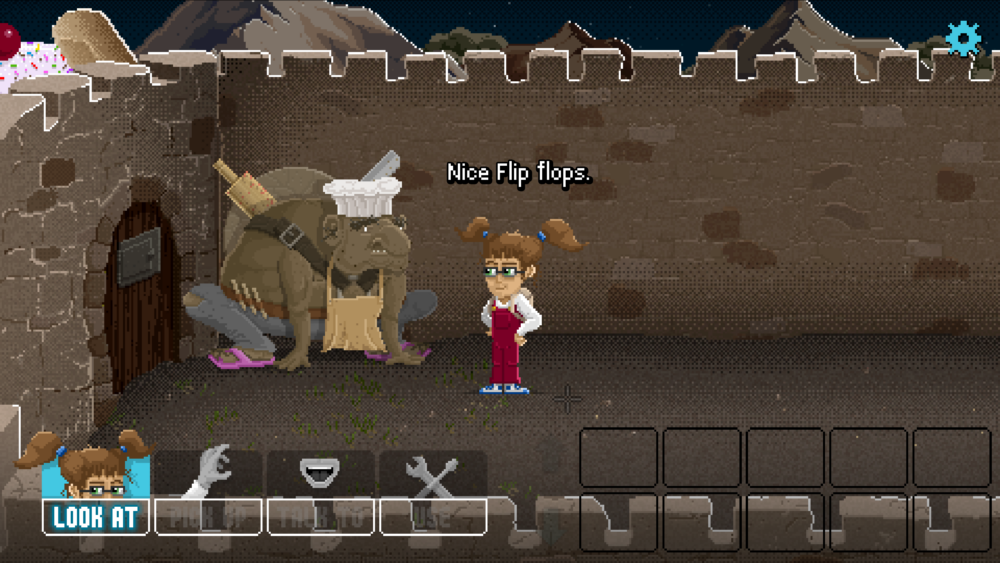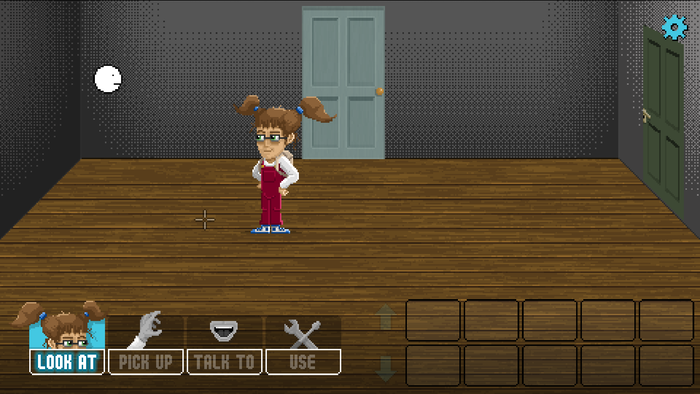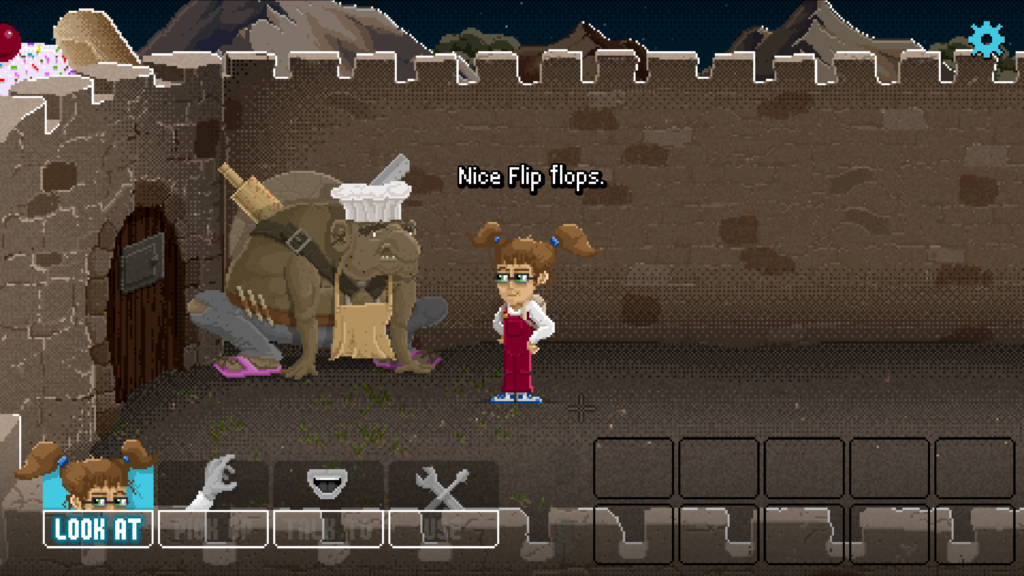Talking to myself

After my recent devlog about puzzle design I have been chatting to other people, players and devs about some of the themes in the post. One thing that came up was the fact that I talk to my characters.
I’m aware that this makes me sound like I’m a sultana short of a fruitcake but hear me out.
I’ve spoken before about the fact that I like to build up my scenes with additional elements which aren’t necessary to the “planned” narrative (things like drawers, cupboards, boxes and additional scenery which adds personality and interest to a scene). I then import them into the game engine and start walking around amongst them, clicking on them to see what I think could happen. I might even go as far as to add short animations of drawers and cupboards opening to see if it sparks any ideas. Due to the low-res pixel-artwork (and the fact that I am designing, writing, drawing and developing the game myself), this doesn’t add too much to the process in terms of time or money, and has been the springboard for some of my games’ most popular and original puzzles.
I love playing adventure games, and being able to add it as part of my design process helps me to see the game through a player’s eyes. I don’t know what I’m going to find any more than someone playing my game for the first time. I love that excitement, and it helps me to see what could be potentially funny, surprising or disappointing while exploring the game.
My process is always evolving, and I haven’t analysed it as a whole in any great detail, so it came as a slight shock to me when I had to admit to someone that I apply the same method to my characters.
My ad-hoc character development process
Most characters have a part to play in the “necessary” puzzles in the game – the ones that further the narrative significantly – so that is my starting point. I know what the character interaction needs to achieve in terms of revealing clues, providing items or just getting in the way, but getting to that point is the fun part.
So, now I have a character (usually just a test smiley face) standing where I want them. I boot up the dialogue system in the game engine and add a simple “Hello” and “Goodbye” action to allow me to open and close the dialogue. At this stage, I usually (but not always) have a rough idea about the personality of the character. They may be grumpy, eccentric, kind, evasive etc. if the puzzle requires it. Sometimes, if their role is minor, I will just start writing a response and see what feels right. When the main character introduces themselves, I might write “Bugger off!”, “Hello my dear.” or “What’s wrong with your hair?” and see where it takes me. I have also noticed that I have a tendency to write slightly more grumpy/sarcastic characters, so I need to keep that in check to ensure that I don’t end up with a cast of clones who make the player’s life a misery from start to finish…they are more fun to write though!

Once I have set the tone of the dialogue, I will look around the scene and see if there are any things that the characters might likely talk about (the weather, things in a shop, the narrative so far). More often than not, this provides me with a nice segue into talking about the matter in hand – why the character was created in the first place.
For example, imagine I have a florist’s shop, and you need to give a clue about a specific flower (like the scent of a rose), I might start a conversation along the lines of:
- Lucy: “Hi.”
- Shopkeeper: “Welcome to ‘World of flowers’, how may I help you?”
- Lucy: “You sell flowers?”
- Shopkeeper: “What gave it away?”
- Lucy: *PAUSE*
- Lucy: “What’s with all the sausages?”
- Shopkeeper: “Oh. You noticed those.”
- Shopkeeper: “They keep the flies off my display.”
- Shopkeeper: “They’re attracted by the roses’ beautiful scent.”
- Lucy: “I can’t smell them.”
- Shopkeeper: “That’s probably because of all the sausages.”
- Shopkeeper: “Give one a sniff, you’ll see what I mean.”
- Lucy: “A sausage?”
- Shopkeeper: “No, a rose.”
I had literally no idea what I was going to write when I started this. I don’t really know where the sausages came from – Probably just the fact that “sausage” is an inherintly funny-sounding word – but I knew I wanted to give a clue about a flower in a way that didn’t make it too obvious.
I could then change/remove the last 2-3 lines if I want to tweak how obvious the hint is.
If I had already drawn the shop scene before this point, I would now have to draw a load of sausages hanging from the ceiling and animate a few flies, but as far as I’m concerned that’s all part of the process. I would never have thought about sausages until I felt like I was actually “talking” to the character in this way.
P.S. I really want to include this scene in the game now. I’ll see how much time I have left at the end.
At some point I will need to actually draw the character.
Sometimes I do this at the start, and I might give them a weird accessory or appearance which can be remarked upon either in the dialogue, or just when the player “Looks at” the character.
This was the approach I took with the character I created in my recent live Twitch stream. Anyone watching the stream will have seen that I didn’t have many pre-conceived ideas dictating exactly how he should look. The pink flip flops were a nice surprise during the drawing process!

If I have drawn them early on, it will spark ideas for the dialogue, but if I have written the dialogue first, by the time I get around to drawing the character I will have a much more solid idea about how they should look, what their overall demeanour is, or what they are wearing etc.
Whichever way around I do it the different parts of the process all feed into each other.
Disclaimer
I know that this method really wouldn’t work for a lot of writers and devs, so please don’t think that I am recommending it. For me though, it’s far more fun than trying to plan it all out in detail at the start of the project.
Experienced devs will most likely read this and think “OK, you say you’re having fun with your ‘organic’ design process, but really you’re just too lazy to organise and plan properly.” and this would be a fair comment. However, for now at least, it really works for me and provides me with ideas for characters, puzzles and dialogue that I don’t believe I could ever come up with if I couldn’t bounce between dialogue, artwork and exploration of the game environment during the process.
Re-reading my post above, maybe my dialogue-writing process isn’t so different to someone’s who plans and writes them early on (I mean, I wrote all that stuff about sausages without any artwork in front of me). Maybe it’s just a matter of when I write it and being prepared for the knock-on effect it can have on the artwork and development.
I’ve said this before, but this devlog is an unfiltereed brain-dump as I build my first full-length game. It is intended to provide a window into my own thoughts, insecurities and discoveries. Clearly it is not intended as a guide to creating your own adventure game!
Tom x
Back to blog